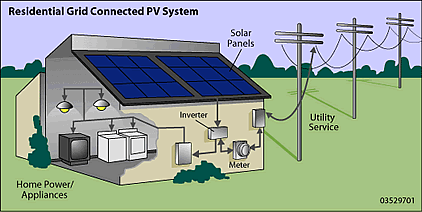
Off-Grid Solar PV
|
Grid-Tied Solar PV Electric Power
SOLAR ELECTRIC PHOTOVOLTAIC MODULES convert sunlight into electricity with no moving parts, no maintenance, no pollution, and no fossil-fuels.
Great Solar Works! solar photovoltaic (pv) systems are custom designed for the amount of power needed. We work with all of our customers to design a system based on a comprehensive Energy Load Evaluation as well as how much power should be collected and stored to provide maximum performance without impacting lifestyle. Like all of our power and heating systems, they are designed to achieve the maximum efficiency, reliability, longetivity and to minimize maintenance. Our systems can be installed on existing residential, commercial, or industrial buildings; or incorporated into the architectural design and construction of a new building. Please check out our recommended resources for homeowners and builders on this page.
Photovoltaic (PV) systems (solar power systems) convert sunlight into electricity. They are modular and can be used in conjunction with other power sources including the conventional power grid. Solar power systems produce clean, reliable power for 30 years or more. The payback period for most grid-tied systems after rebates and financial incentives is around 5 years. In Colorado rebates combined with the Federal Tax Credit can cut the cost of a solar or wind power system by more than 50%!
Grid-tied systems produce power during sunny periods and draw power from the grid during sunless hours. Some utility companies will pay wholesale rates to their customers that generate a surplus of power during a billing cycle. The total usage of grid power is measured with a net-meter. Grid-tied systems can be more ecomical than off-grid systems, because PV arrays might be smaller and batteries are optional.
Battery backup to store power onsite is an option with grid-tied systems but is not mandatory. Batteries will provide power during blackouts.
How PV works:
A single PV cell typically produces only a small amount of power, so cells are connected together to form panels or modules. Modules output 10 to 300 watts each. Depending on power needs, modules are combined into arrays that can be installed on a building or at ground-level on a pole mount.
PV arrays are designed to collect the most sun available at a specific site. Systems are designed to be mounted south-facing at fixed angles, or they can be mounted on a tracking device that follows the sun throughout the day.

|
 |
 Home | About Us | Contact Us | Services | Rebates | Links | Energy Load Evaluation Form | Testimonials
Home | About Us | Contact Us | Services | Rebates | Links | Energy Load Evaluation Form | Testimonials


